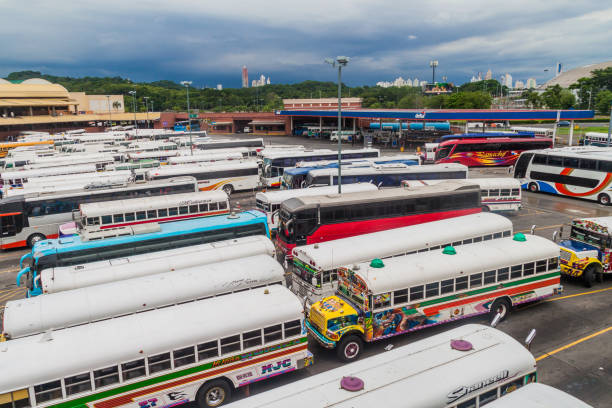Public Transportation in Panama City Needs Improvements

Panama City, Panama - May 30, 2016: Buses wait at Albrook Bus Terminal in Panama City.
There are many challenges for the new government in areas of public transportation. One of the challenges that the incoming Government will face is stabilizing the public transportation crisis in the capital, of which the metrobus is an important part. Nearly 400,000 people use this service daily and are having troubles. People ask for more buses for them to arrive at work or at school on time, while the operating company maintains that the management model no longer works. The queues are the most obvious expression of the crisis that the capital’s bus service is experiencing, and which is decreasing the quality of life for thousands of bus users. The crisis also affects the city’s productive capacity and costs millions of dollars. Workers and students sacrifice hours in long waits at stops and in the traffic jams on board the bus. The worst thing is that this inefficiency suggests to those people who can, to start using a car to gain better movement. However that becomes a worse situation due to the traffic they generate. The metrobus system costs taxpayers $129 million this year, but people are demanding something better. And that is the inheritance that the new Government receives.
The answer to why buses take time to arrive is complex. MiBus says it has 1,200 buses in total, and that to function well it needs 900 of these buses operational per day. Today there are only 600, and 450 of them do not have air conditioning parts due to a conflict with a company that won a $12.5 million contract to provide them and they did not arrive, a case that escalated to the supreme court of justice case and remains unresolved. The rest of the buses, the company assures, are under regular maintenance. Consequently, the operation centers, such as El Chorrillo, have large parking lots. The transportation crisis is part of an even bigger crisis: that of institutions, one of the big problems that the new government will have to face. It is seen in the garbage crisis, spread throughout the city, and it is also seen on the buses.
The manager of MiBus, Luis Campana, assured that in 2021 he designed a plan to reform the way the system operates, that as happens in cities like Bogotá or Santiago de Chile, a technical entity will be created to regulate all public transport services in the capital, and that the operation of the buses was concessioned to private companies, but no one is making good decisions. This is also a story of the State. Some experts maintain that institutional changes are the first thing the new government must do if it wants to stop the bleeding. In any case, it is a systemic emergency: while the metrobuses do not show up because there are none, the pirate buses grow, the red devils return and the taxis reproduce en masse and exceed 47 thousand in the city. But for none of these crises have had a response.
In 2022, the Transit Authority forced MiBus to cut one of the most used routes, the Costa del Este-Metro San Miguelito, to give space to the red devils. Not satisfied with that, it also forced the frequency during peak hours to be reduced by half. The state played in favor of the disorder and today people must make more connections to use the service. Will the state’s plans continue in the face of the ordeal that tens of thousands of Panamanians are going through, punished for the inefficiency of the service they provide? Will the public transportation system be comprehensively restructured? Where will the multimillion-dollar resources required for all these changes come from? These are the challenges that the new Government faces in the face of the public transport crisis.





